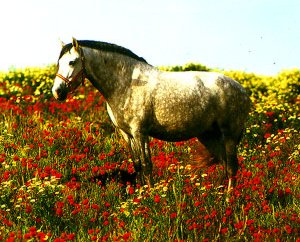
The stallion Esclavo is said to have had warts under his tail, and his characteristics were passed on to his offspring. Some breeders felt that without the warts, a horse could not be of the Esclavo blood line. Another characteristic sometimes seen in the Carthusian is the evidence of "horns", actually frontal bosses thought to be inherited from Asian ancestors. The descriptions of the "horns" vary from calcium-like deposits on the temple to small horns behind or near the ear. Unlike the warts beneath the tail, the horns were not considered proof of Esclavo descent.
Throughout the centuries that followed, the Carthusian monks guarded their bloodlines, even defying a royal order to introduce Neapolitan and central European blood.
Don Pedro and Juan Jose Zapata bought a good number of mares from the Carthusians. In 1854 Don Vincent Romero y Garcia, a Jerez Landlord, purchased what he could of the excellent group of horses. Don Vincent lived to be ninety-two years old and because of his knowledge of breeding, greatly improved the quality of the horses without using any outside blood.
Without the dedication of the Carthusian monks, the Zapata family, and a few other breeders who refused to cross their horses with other breeds, the purest line of Andalusion blood would have been lost to the world.
Today Carthusian horses are raised in state-owned studs around Cordoba, Jerez de la Frontera, and Badajoz. The predominant color is gray, attributed to the important influence of two stallions of this color early in the twentieth century. Some Carthusians are chestnut or black. Nearly all of the modern Carthusians are descended from the stallion Esclavo.
The Carthusian head is light and elegant with a slightly convex profile, broad forehead, small ears, and large, lively eyes. The neck is well proportioned and arched; the chest is broad and deep; the shoulder sloping; the back short and broad; the croup sloped; and the legs are sturdy with broad, clean joints. Nearly all members of this breed have good conformation.
Population Status: RARE